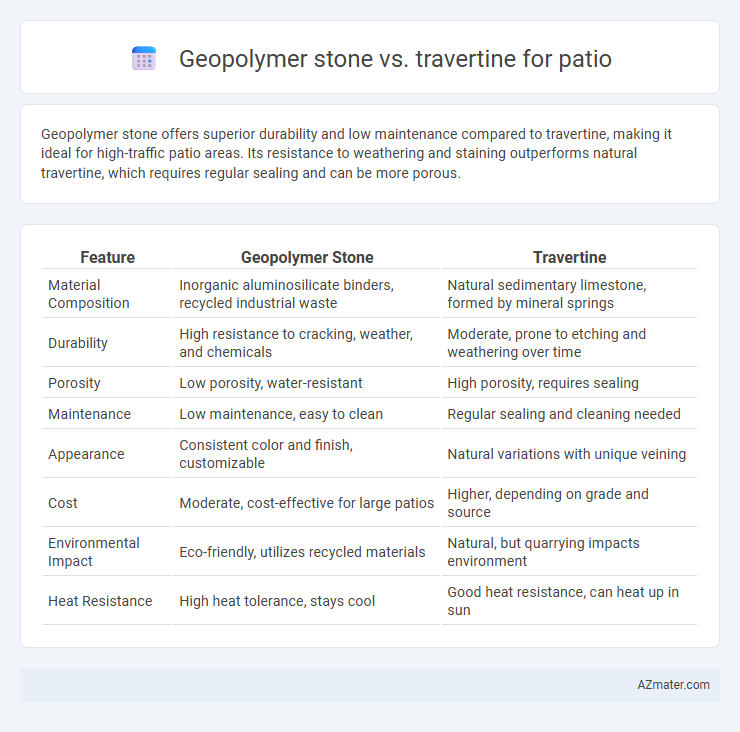Geopolymer stone offers superior durability and low maintenance compared to travertine, making it ideal for high-traffic patio areas. Its resistance to weathering and staining outperforms natural travertine, which requires regular sealing and can be more porous.
Table of Comparison
| Feature | Geopolymer Stone | Travertine |
|---|---|---|
| Material Composition | Inorganic aluminosilicate binders, recycled industrial waste | Natural sedimentary limestone, formed by mineral springs |
| Durability | High resistance to cracking, weather, and chemicals | Moderate, prone to etching and weathering over time |
| Porosity | Low porosity, water-resistant | High porosity, requires sealing |
| Maintenance | Low maintenance, easy to clean | Regular sealing and cleaning needed |
| Appearance | Consistent color and finish, customizable | Natural variations with unique veining |
| Cost | Moderate, cost-effective for large patios | Higher, depending on grade and source |
| Environmental Impact | Eco-friendly, utilizes recycled materials | Natural, but quarrying impacts environment |
| Heat Resistance | High heat tolerance, stays cool | Good heat resistance, can heat up in sun |
Introduction to Geopolymer Stone and Travertine
Geopolymer stone is an innovative, sustainable building material made from industrial by-products such as fly ash and slag, offering high durability and resistance to weathering for outdoor patios. Travertine, a natural limestone formed from mineral springs, is prized for its classic, porous texture and warm, earth-toned appearance that ages gracefully in outdoor settings. Both materials provide unique aesthetic and functional benefits, with geopolymer stone excelling in eco-friendliness and strength, while travertine is favored for its timeless elegance and natural origin.
Composition and Formation
Geopolymer stone is an engineered material made from aluminosilicate minerals combined with alkali activators, resulting in a synthetic stone formed through a chemical reaction at low temperatures. Travertine is a natural sedimentary rock composed primarily of calcium carbonate deposited by mineral springs, particularly hot springs, forming through the precipitation of carbonate minerals over thousands of years. The artificial composition of geopolymer stone offers enhanced durability and customization compared to the porous, naturally occurring travertine, which is valued for its unique, earthy textures and color variations.
Aesthetic Differences
Geopolymer stone offers a uniform, modern appearance with customizable colors and textures that mimic natural stone while providing enhanced durability. Travertine is prized for its classic, porous surface with distinct veining and warm earth tones that create a timeless Mediterranean aesthetic. The choice between Geopolymer stone and Travertine for patios depends on whether a sleek, contemporary look or a natural, rustic elegance is preferred.
Durability and Longevity
Geopolymer stone exhibits superior durability compared to travertine, resisting cracking, chipping, and weathering due to its dense, engineered composition. While travertine, a natural limestone, is porous and prone to erosion and staining over time, geopolymer stone maintains structural integrity and color retention under harsh patio conditions. For long-term outdoor use, geopolymer stone delivers enhanced longevity and reduced maintenance costs, making it a more resilient choice for patios.
Slip Resistance and Safety
Geopolymer stone offers superior slip resistance compared to travertine, making it a safer option for patio surfaces in wet or humid conditions. Its textured finish and higher friction coefficient reduce the risk of slips and falls, especially around pools or areas prone to moisture. Travertine, while aesthetically pleasing, tends to be smoother and more porous, which can lead to increased slipperiness and requires regular sealing to maintain safety.
Environmental Impact and Sustainability
Geopolymer stone offers a significantly lower carbon footprint compared to travertine, as its production uses industrial byproducts and requires less energy-intensive processes. Travertine quarrying causes habitat disruption and landscape degradation, whereas geopolymer stones are manufactured from recycled materials, reducing natural resource depletion. Choosing geopolymer stone for patios supports sustainability goals through reduced emissions, waste valorization, and enhanced durability, making it an eco-friendly alternative to natural travertine.
Installation Process and Maintenance
Geopolymer stone offers a straightforward installation process with its lightweight and uniform slabs, reducing labor time compared to natural travertine, which requires precise fitting and sealing to prevent moisture infiltration. Maintenance for geopolymer stone is minimal since it resists staining, chipping, and weathering, while travertine demands regular sealing and careful cleaning to preserve its porous surface and prevent erosion. Choosing geopolymer stone enhances durability and lowers upkeep costs, making it ideal for patios exposed to harsh weather conditions.
Cost Comparison
Geopolymer stone offers a cost-effective alternative to travertine for patios, with prices typically ranging from $15 to $30 per square foot compared to travertine's $25 to $50 per square foot. Installation costs for geopolymer stone are generally lower due to easier handling and faster setting times, reducing labor expenses by up to 30%. Maintenance expenses also favor geopolymer stone, as it is more resistant to staining and weathering, resulting in long-term savings over travertine's need for periodic sealing and repairs.
Weather Resistance and Climate Suitability
Geopolymer stone offers superior weather resistance compared to travertine, with enhanced durability against freeze-thaw cycles and moisture absorption, making it ideal for patios in harsh climates. Travertine, while appealing with its natural look, is more porous and prone to weathering, requiring regular sealing to maintain its appearance and structural integrity. For regions experiencing extreme temperature fluctuations or heavy rainfall, geopolymer stone ensures longer-lasting performance and minimal maintenance.
Which Patio Stone is Right for You?
Geopolymer stone offers high durability, low maintenance, and eco-friendly benefits ideal for patios exposed to heavy weather and frequent use, while travertine provides a natural, elegant aesthetic with unique veining but requires regular sealing and is more porous. Choosing between geopolymer stone and travertine depends on your priorities for sustainability, durability, budget, and the desired look of your outdoor space. Geopolymer stone suits modern, low-maintenance patios, whereas travertine fits traditional styles that value natural stone beauty despite higher upkeep requirements.

Infographic: Geopolymer stone vs Travertine for Patio
 azmater.com
azmater.com